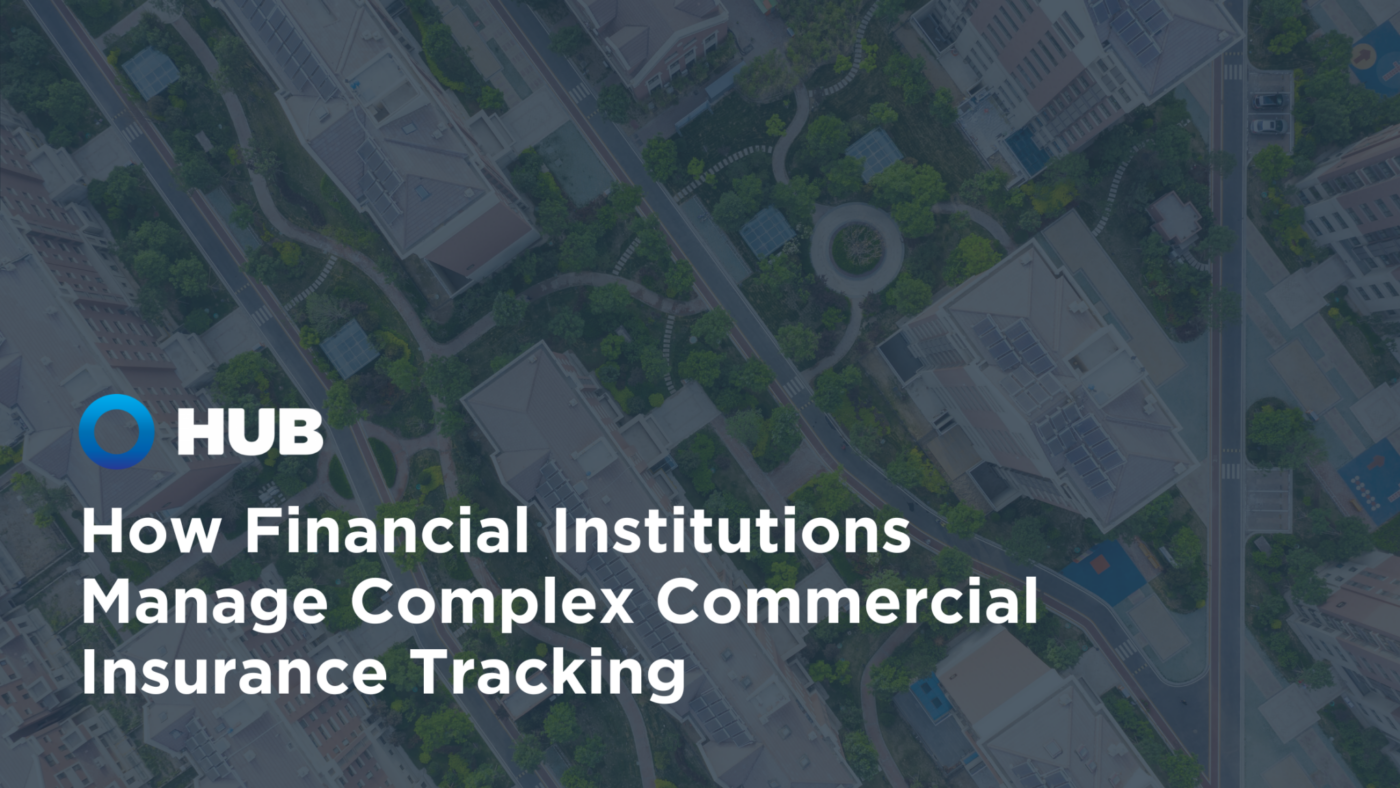How Financial Institutions Manage Complex Commercial Insurance Tracking
Author: Leo Bracho
Table of Contents
Managing multifamily and commercial insurance tracking, perils, and collateral has become increasingly crucial for financial institutions. However, the challenges to do this correctly are vast and ever changing (“complex commercial”).
- Many financial institutions that track borrower insurance internally rely on rigid servicing systems, making it difficult to maintain accurate data on commercial properties and collateral. It is not uncommon for servicers to use multiple servicing platforms to accomplish all their needs.
- These issues are exacerbated by complicated servicing requirements, coupled with gaps in servicing systems, poor data integration, and the challenges posed by sophisticated insurance policies.
As a result, inaccurate data can lead to incomplete insurance tracking, increasing the risk that uncovered events could harm the lender’s assets and create a negative customer experience.
Additionally, outdated information (e.g., accurate RCVs) limits the lender’s ability to assess property valuations and risks, increasing loss exposure.
A clear strategy for managing commercial insurance tracking can protect lenders and servicers from financial risk, align with investor requirements, and improve compliance with regulatory and servicing standards. Here are four key points to consider:
- Addressing Data Quality in Servicing Systems
- Embracing Cumbersome Collateral Tracking and Property Valuations
- Managing Package Policies and Perils Coverage
- Understanding Ambiguities in Policy Language
Let’s break down each one in more detail.
Addressing Data Quality in Servicing Systems
Financial institutions rely heavily on servicing systems to maintain critical loan and collateral information. However, many systems struggle with data quality issues. Things like outdated information, incomplete records, cumbersome collateral recording in the core system, and inconsistent tracking methods all play a role.
These issues can lead to significant discrepancies, impacting loan accuracy, investor confidence, and compliance. HUB Financial Services provides solutions for:
- Enhanced Data Management: High-quality data provides insights needed to manage risk effectively. Poor data can lead to inaccuracies in understanding loan exposures, undermining risk models and assessment strategies. A robust quality assurance program should help manage these risks from various angles.
- Regulatory Compliance: Accurate data on collateral and insurance is essential for meeting regulatory requirements, especially as authorities increasingly scrutinize financial institutions’ asset management practices.
- Resilient Insurance Tracking: Our insurance tracking programs are customized to align with our client’s needs. This means we remain flexible when crafting commercial insurance tracking programs that plug into existing servicing environments.
Embrace Cumbersome Collateral Tracking and Property Valuation
Accurate collateral tracking is vital in ensuring that coverage requirements align with the assets securing them. Without precise collateral data and property valuations, lenders may overstate or understate their exposure, risking financial stability and regulatory challenges. Advanced complex commercial insurance tracking for perils and collateral helps with:
- Mitigating Collateral Risk: By accurately valuing and identifying collateral, lenders and servicers can better understand the real risk associated with each loan. This ensures the balance sheet accurately reflects assets and liabilities, helping make strategic investment and lending decisions.
- Supporting GSEs and Other Investor Requirements: Government-sponsored enterprises (GSEs) and other investors impose specific insurance requirements on collateral. Those requirements must be tracked to ensure compliance throughout the life of the loan. By focusing on data accuracy, financial institutions can meet these demands, maintaining investor trust and meeting compliance standards.
- Streamlining Asset Management: Updated collateral information supports better portfolio management by providing reliable data on asset values, risk exposure, loan-to-value ratios, and overall portfolio health.
Managing Package Policies and Perils Coverage
Commercial loans often involve large, intricate insurance policies that cover various perils and risks, whether the coverages are provided by a single or many independent insurance carriers. Managing these complex policy stacks can be challenging, especially when document management systems are not equipped to handle lengthy and detailed insurance documentation. Effective commercial insurance tracking can lead to significant benefits:
- Compliance with Loan Covenants: Complex loans come with specific insurance requirements that must be reviewed periodically to remain compliant. To do that effectively, lenders need the ability to capture and evaluate complex policy perils, endorsements, exclusions, and other policy language.
- Enhanced Portfolio Resilience: By managing the insurance coverage effectively, lenders can reduce risk exposure for both them and their borrowers. Comprehensive commercial insurance tracking ensures that the collateral backing the loans are adequately protected.
- Risk Mitigation for Balance Sheet Health: Properly insured assets contribute to balance sheet stability, helping prevent potential losses from underinsured or uninsured collateral.
Addressing Ambiguities in Policy Language
The language in commercial insurance package policies can often be complicated or seem contradictory, leading to confusion with coverage conditions and compliance requirements. To ensure the people responsible for conducting insurance reviews understand the intricate complexities of various insurance contracts, enhanced training and education is often necessary. This creates potential challenges in both assessing and managing risk:
- Clarifying Policy Requirements: Lenders and servicers must understand complex policy language to ensure that coverage aligns with loan requirements. To do this effectively means investing in quality training and support for those involved with insurance servicing. Effective language interpretation helps prevent misunderstandings that could lead to non-compliance or financial loss.
- Reducing Legal and Financial Risks: Proactively addressing ambiguities and coverage requirements can help servicers avoid disputes over coverage, enhance claims experience, and mitigate the risk of costly legal challenges.
- Supporting Clear Communication with Borrowers: By clarifying policy language, servicers can better communicate with borrowers about their responsibilities, ensuring they understand their insurance obligations and risks.
Why Effective Complex Commercial Insurance Tracking Works
Improving Data Quality and System Modernization
Enhanced data quality improves the ability to track and verify insurance coverage, ensuring that all perils are accounted for and that the lender’s assets remain protected.
Addressing Complex Policy Language
Deploying adequate training and system tools ensure servicers do not miss critical details, such as excluded perils, special conditions, or insufficient coverage, that could impact their financial standing in the event of a claim.
Meeting Specific Loan and Investor Requirements
By ensuring compliance with these requirements, servicers can avoid costly penalties, maintain investor trust, and enhance the quality of their loan portfolios.
Managing and Processing Large Insurance Packages
Enhanced processing capabilities not only reduce administrative burden but also decreases the risk of lapses in coverage, allowing lenders to handle larger portfolios with greater efficiency and confidence.
Conclusion
Effective management of complex commercial insurance tracking is vital for financial institutions aiming to mitigate risk, ensure compliance, and protect their assets.
With the increased demands from investors, regulatory agencies, and competitive markets, lenders simply cannot afford to rely on outdated systems and processes.
With HUB Financial Services expertise for improving data quality, modernizing workflows, elevating policy reviews, and meeting specific investor requirements, lenders can secure their position and navigate the complex landscape of commercial insurance tracking with greater agility and reduced risk exposure.
Investing in these solutions will help lenders and servicers achieve a stronger, more resilient portfolio, ultimately driving better financial outcomes and enabling long-term growth.
About the Author:
Leo Bracho
Managing Director of Mortgage Services

Leo Bracho is the Managing Director of Mortgage Services at HUB Financial Services. He has been an integral member of HUB’s leadership team since 2013. In his role, Leo is responsible for overseeing all operations within the mortgage division, including Tracking Operations, Client Communications and Account Management, Quality Assurance, and Employee Learning & Development. His strategic oversight and exceptional management skills contribute to the smooth and efficient function of every aspect of the division.
Having joined HUB in 2013, Leo has over 15 years of experience in the insurance and mortgage industry. Throughout his career, he has worked in and with a wide range of financial institutions, gaining valuable insights and expertise. He has worked his way up through loan servicing specialties and account management to earn his current position. Leo possesses a comprehensive understanding of the dynamic mortgage landscape, continuously staying updated with industry trends and regulations. This enables him to provide innovative solutions tailored to meet the unique needs of each client.

Frequently Asked Questions About Complex Commercial Insurance Tracking
What is complex commercial insurance tracking?
Complex commercial insurance tracking involves managing and monitoring insurance policies for multifamily and commercial properties held as collateral by financial institutions. This process ensures that these assets are adequately insured, protecting lenders from potential financial losses due to uninsured events.
Why is accurate data important in commercial insurance tracking?
Accurate data is crucial because outdated or incomplete information can lead to discrepancies in loan records, affect property valuations, and increase loss exposure. Maintaining high-quality data helps in effective risk management, ensures compliance with regulatory requirements, and enhances investor confidence.
What challenges do financial institutions face with servicing systems in insurance tracking?
Financial institutions often rely on rigid servicing systems that may struggle with data quality issues, such as outdated information and incomplete records. These challenges can lead to inaccurate insurance tracking, increasing the risk of uncovered events that could harm the lender’s assets and negatively impact customer experience.
How can financial institutions improve their commercial insurance tracking processes?
To enhance commercial insurance tracking, financial institutions can:
Enhance Data Management: Implement robust quality assurance programs to maintain accurate and up-to-date data.
Ensure Regulatory Compliance: Maintain precise collateral and insurance information to meet regulatory requirements.
Adopt Resilient Insurance Tracking Solutions: Utilize customized insurance tracking programs that integrate seamlessly with existing servicing environments.
What role does policy language play in commercial insurance tracking?
Understanding policy language is essential, as ambiguities can lead to misinterpretations of coverage, potentially leaving assets underinsured. Clear comprehension of policy terms ensures that all perils are adequately covered, aligning with the lender’s risk management strategies.
By addressing these aspects, financial institutions can effectively manage the complexities associated with commercial insurance tracking, safeguarding their assets and ensuring compliance with industry standards.
